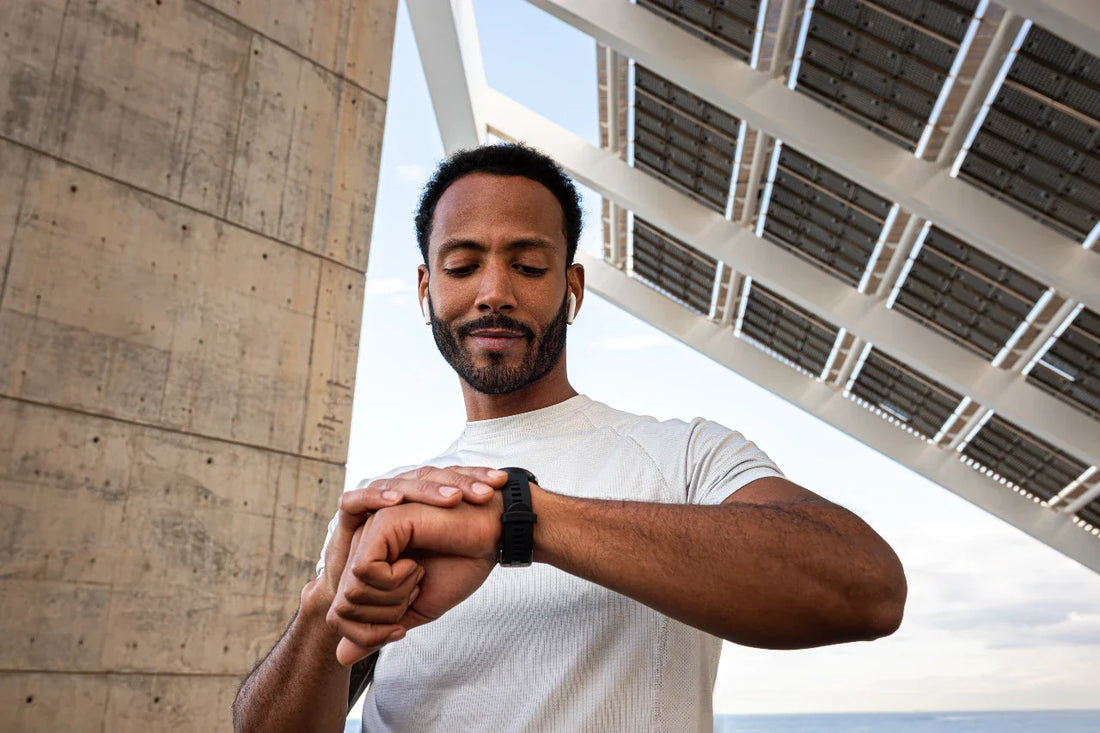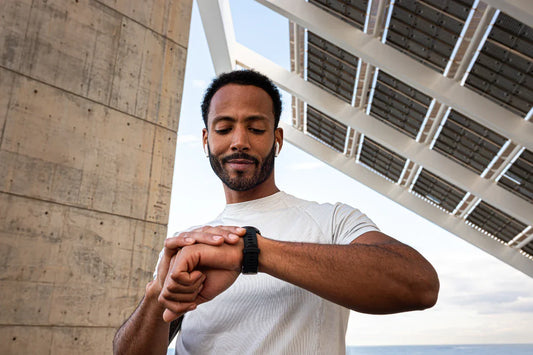
Fertility and Tech: How Wearables & Apps Are Helping Men Track Reproductive Health
Share
From fitness trackers to sleep apps, wearable technology has become an everyday part of health management. Increasingly, men’s reproductive health is entering the digital health space, with new apps and devices promising to monitor sperm quality, hormone balance, and fertility factors.
While this technology offers convenience and insights, it’s important to understand what’s proven, what’s experimental, and how men can use these tools wisely as part of their fertility journey.
Key Takeaways: Wearable Tech & Male Fertility
1. Digital health tools can help men track fertility-related factors.
Wearables like smartwatches and fitness trackers monitor sleep, stress, temperature, and recovery—key lifestyle metrics that influence testosterone and sperm quality. When used alongside clinical testing, they help men identify habits that may support better reproductive health.
2. Not all fertility technology is clinically proven yet.
While apps and smart sperm-testing kits offer convenience and privacy, their accuracy can vary. Research on EMF exposure, heat effects, and scrotal cooling devices is still evolving. For reliable data, men should combine at-home monitoring with lab-verified sperm analysis such as CryoChoice’s at-home kit.
3. The future of fertility tech is AI-driven and personalized.
Emerging platforms are integrating AI, hormone tracking, and telemedicine to deliver deeper insights into sperm health and fertility potential. This shift empowers men to take proactive, data-based steps in managing their reproductive wellness.
The Science of Technology and Sperm Health
Heat and Sperm Production
Sperm production depends on keeping the testes 2–3°C cooler than body temperature. Anything that raises scrotal heat - tight clothing, hot laptops, or certain wearables - can impair sperm count and motility. Long-term heat exposure may also increase DNA fragmentation.
EMF Exposure and Fertility
Studies suggest that heavy mobile phone use is linked to lower sperm count. Wireless devices emit electromagnetic fields (EMFs), but the full impact on sperm health is still debated. With wearables, more research is needed to determine whether EMF exposure or device placement poses risks.
Sleep, Stress, and Hormones
Sleep disruption and chronic stress can reduce testosterone levels, harming fertility. Wearables that track sleep stages, heart rate, and stress levels may offer valuable indirect markers of reproductive health, highlighting lifestyle factors that need attention.
Wearables for Men’s Reproductive Health
Smartwatches & Fitness Trackers
General health wearables like Apple Watch, Garmin, and Fitbit don’t measure fertility directly, but they can provide valuable context. By tracking sleep quality, activity levels, and stress markers, these devices highlight lifestyle patterns that indirectly affect sperm health. For men working on fertility, insights on recovery and stress management can be especially useful.
Temperature Monitoring Devices
Newer tech is targeting male fertility more directly. Some devices are designed to monitor or regulate scrotal temperature, since overheating the testes can impair sperm production. Scrotal cooling pads and temperature sensors are being developed to support healthier sperm function, though research on long-term benefits is still evolving.
Advanced Male Fertility Devices
Finally, a new category of smart sperm testing kits allows men to assess sperm health at home. Tools like YoSperm and ExSeed connect with smartphone apps to measure count, motility, and sometimes morphology. While they offer convenience and privacy, it’s important to remember that clinical-grade testing through certified labs, like CryoChoice’s at-home kit, provides the most reliable results.
Fertility Apps for Men
Semen Analysis & Tracking Apps
Some apps connect with smartphone-compatible sperm tests, allowing men to measure count and motility at home. Beyond one-time results, these tools can track changes over time, helping users identify trends in sperm health.
Lifestyle & Nutrition Apps
Other apps focus on the bigger picture: diet, exercise, supplement intake, and alcohol use. By tracking these habits, men can build healthier routines that directly support reproductive health.
Couple-Based Fertility Apps
Finally, some fertility platforms are designed for couples. These apps sync male data with a partner’s cycle tracking, making it easier to align fertility windows and plan conception together.
Benefits of Technology for Male Fertility – But Use Caution
Fertility technology has clear upsides. Apps and wearables make it easier for men to track lifestyle factors like sleep, stress, and activity, areas that directly affect sperm health. At-home devices also offer privacy and convenience, and unlike a one-time clinic visit, they can provide continuous insights over time. For men who want to be proactive, this can mean earlier detection of potential fertility issues and a greater sense of control.
That said, it’s important to use these tools wisely. Accuracy can vary widely between consumer devices, and relying only on apps may delay needed medical care. Some devices may generate extra heat or EMF exposure, which is a concern in sperm health research, though the risks remain under study. Most importantly, digital health tools should be seen as a complement, not a replacement, for clinical guidance.
For men who want the convenience of at-home tracking without sacrificing lab precision, the safest approach is combining everyday tools with clinical-grade testing like CryoChoice’s at-home sperm analysis kit. This ensures data you can trust, while still benefiting from the convenience of modern technology.
Limitations and Risks to Consider
While fertility tech is advancing quickly, it’s important to keep expectations realistic. At-home sperm testing kits can be helpful for tracking trends, but they don’t always match the precision of full laboratory analyses. Similarly, the impact of wearables on sperm health is still an emerging field - long-term studies are limited, and much of the science is in its early stages.
Most importantly, digital health tools should be viewed as a complement, not a replacement, for clinical guidance. Wearables and apps can provide useful insights into lifestyle and fertility, but regular checkups with a healthcare provider remain essential for accurate diagnosis and treatment.
The Future of Fertility Tech
Innovation in this space is moving fast. Researchers are already exploring AI-powered fertility predictions that combine data from sleep, hormone levels, and semen analysis to give men a more complete picture of reproductive health. At the same time, wearables and fertility apps are beginning to integrate with telemedicine platforms, allowing men to share real-time data with specialists for personalized coaching and treatment.
Perhaps most promising, there’s now a growing market of male-focused fertility technology - a shift that is helping men take a more proactive role in their reproductive health, rather than being an afterthought in family planning.
Resources for Fertility & Technology
-
News-Medical – Mobile phones & sperm count study – Highlights the link between heavy phone use and sperm count decline.
-
NIH – Wearable technology research – Current studies on how wearables impact health outcomes.
-
CryoChoice Sperm Testing & Freezing – At-home sperm testing and storage that integrates with modern fertility planning.
Frequently Asked Questions About Fertility & Technology
Do smartwatches affect sperm health?
There’s no evidence that wearing a smartwatch directly harms sperm. The real fertility concerns are lifestyle-related—poor sleep, stress, or inactivity. Wearables can actually help by tracking these metrics, and men can use the insights alongside clinical testing, like the at-home kits offered by CryoChoice, to build a more complete picture of reproductive health.
Can scrotal cooling devices actually improve sperm quality?
Some small studies suggest that targeted scrotal cooling may improve sperm count and motility, but results are mixed. These devices should be seen as experimental rather than proven treatments.
Are at-home sperm testing kits accurate?
Most consumer kits only give limited insights (count or motility). A full lab-based semen analysis is still the gold standard. The CryoChoice clinical-grade at-home kit combines home collection with expert lab analysis, offering the convenience of home with results you and your doctor can rely on.
Do mobile phones or wearables cause infertility?
Heavy mobile phone use has been linked to lower sperm counts, likely due to heat or EMF exposure, but more research is needed. Wearables emit much less energy than phones, though moderation and caution are always wise.
Conclusion
Wearables and apps are changing the way men engage with fertility, making sperm health tracking more accessible and proactive. But while technology offers valuable insights, it should never replace medical expertise.
For men serious about their reproductive health, the best approach is a balanced one: use wearables for daily awareness, pair them with regular medical checkups, and consider proactive steps like sperm testing and freezing with CryoChoice.
In short, fertility tech can guide you, but testing, freezing, and expert care are what secure your reproductive future.


